| Author |
Message |
Harry Marinakis

|
|
  |
 |
Harry Marinakis

|
 Posted: Wed 15 Oct, 2014 5:11 am Post subject: Posted: Wed 15 Oct, 2014 5:11 am Post subject: |
 |
|
I'll start the conversation.
What are the different methods that you use for making rain guards?
I have used the method decribed by Peter Johnsson, where the leather is cut, folded and sewn.
http://www.yeoldegaffers.com/projects/scabbard/instructions.jpg
What sewing patterns have you used on the edges of the rain guard?
|
|
  |
 |
|
Lance Morris
|
 Posted: Wed 15 Oct, 2014 9:08 am Post subject: hey Posted: Wed 15 Oct, 2014 9:08 am Post subject: hey |
 |
|
Hey guys,
Im so glad you started this thread. Ive been making scabbards for a few years now and im getting better! still need help though.
Ive been having trouble with rain gaurds. im doing the same technique as your link but then the woods exposed. I own a scabbard from valiant armoury the rain guard completely covers the wood core.... so there is hope
 Attachment: 130.05 KB Attachment: 130.05 KB
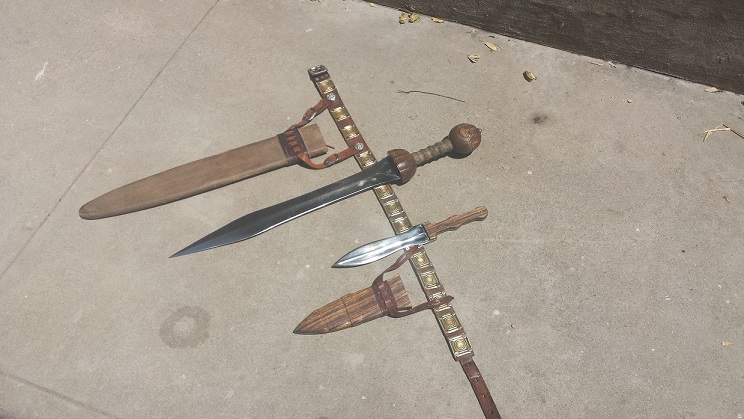
 Attachment: 41.9 KB Attachment: 41.9 KB
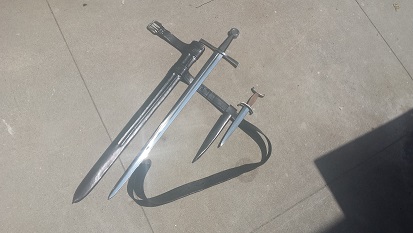
|
|
  |
 |
Dean F. Marino

Location: Midland MI USA Joined: 24 Aug 2011
Posts: 229
|
 Posted: Wed 15 Oct, 2014 10:29 am Post subject: Posted: Wed 15 Oct, 2014 10:29 am Post subject: |
 |
|
Preferring semi-circular rain guards - I cheat.
I laminate a second piece of leather, rough to rough, so the laminated section extends 1" below the scabbard throat. This is cut as a UNIT, then X stitched. An example...

In edhil, hai edhil. In edain, hai edain.
|
|
  |
 |
J. Nicolaysen

|
 Posted: Wed 15 Oct, 2014 10:54 am Post subject: Posted: Wed 15 Oct, 2014 10:54 am Post subject: |
 |
|
|
As a wool producer I would be interested to know where you guys get the wool for lining a DIY scabbard and how you attach it. Also what kinds of wool have worked best.
|
|
  |
 |
Matthew Bunker

Location: Somerset UK Joined: 02 Apr 2009
Posts: 483
|
 Posted: Wed 15 Oct, 2014 12:55 pm Post subject: Posted: Wed 15 Oct, 2014 12:55 pm Post subject: |
 |
|
| J. Nicolaysen wrote: | | As a wool producer I would be interested to know where you guys get the wool for lining a DIY scabbard and how you attach it. Also what kinds of wool have worked best. |
Early medieval scabbards were lined with skin (with the hair/fleece still on) rather than loose wool or textile, usually sheepskin (although I've also used beaver and other animal skins). The problem is that modern sheep have usually been bred to have thick, springy fleece which is totally different to the finer straight haired fleece of period breeds..the skins are too thick as well.
But small goat skins are perfect. Thin skin, fine, straight hair all going in the same direction. If you want to line an early medieval scabbard with something, goat is what you want.
Unless you know someone who breeds Soay sheep.
"If a Greek can do it, two Englishman certainly can !"
|
|
  |
 |
Harry Marinakis

|
 Posted: Wed 15 Oct, 2014 4:58 pm Post subject: Re: hey Posted: Wed 15 Oct, 2014 4:58 pm Post subject: Re: hey |
 |
|
| Lance Morris wrote: | | Ive been having trouble with rain guards. im doing the same technique as your link but then the woods exposed. |
I have been adding a leather "bumper" to the wood core, made from 7-8 oz veg tan leather, dyed the same color as the cover. This way the wood is not exposed. (This was the very first scabbard I ever made, so the workmanship is not that great.) I have also seen some people dye the wood throat with the same dye that was used for the leather cover.
 Attachment: 62.11 KB Attachment: 62.11 KB
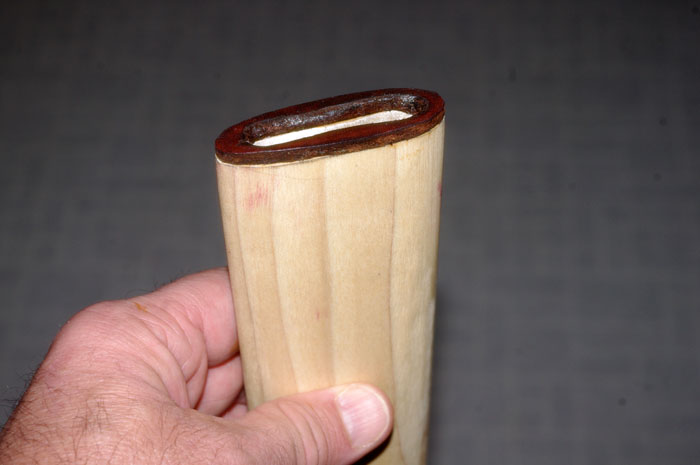
Last edited by Harry Marinakis on Wed 15 Oct, 2014 5:04 pm; edited 1 time in total
|
|
  |
 |
Harry Marinakis

|
 Posted: Wed 15 Oct, 2014 5:03 pm Post subject: Posted: Wed 15 Oct, 2014 5:03 pm Post subject: |
 |
|
The leather "bumper" is also useful for scabbards that don't have a rain guard. I am working on an iron-age sword & scabbard, and the plain wood core was marring the finish on the sword's lower cross. So I added a leather "bumper" to pad the seat.
I took a cheap Pakistani leaf blade and made a new hilt from West Africa ebony and boxwood. I am still working on the scabbard, gonna add an engraved bronze locket and a cast chape with an animal head.
 Attachment: 48.91 KB Attachment: 48.91 KB
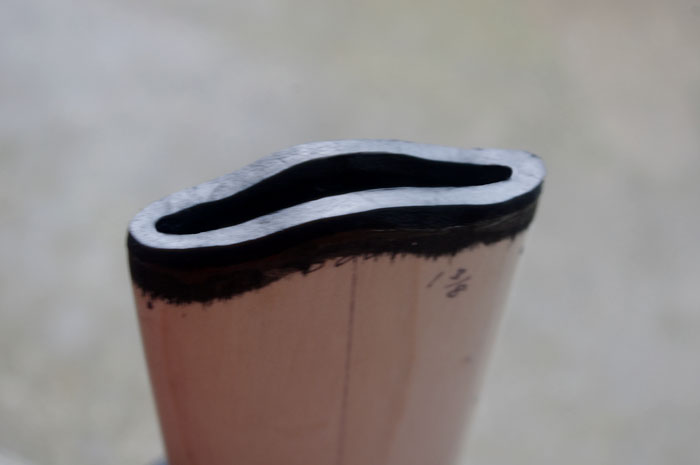
 Attachment: 95.06 KB Attachment: 95.06 KB
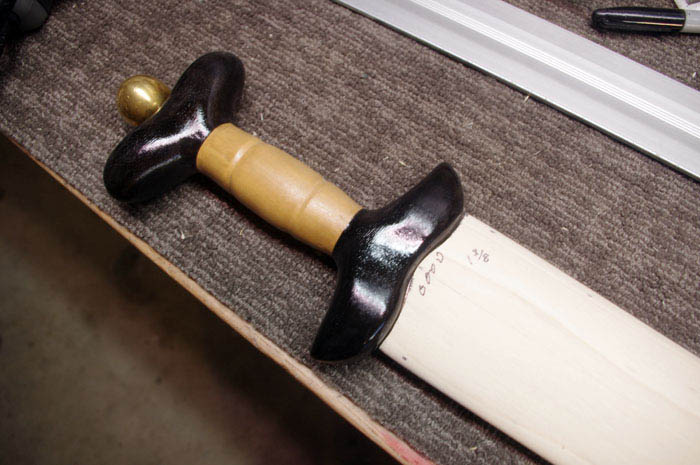
|
|
  |
 |
Harry Marinakis

|
 Posted: Wed 15 Oct, 2014 5:11 pm Post subject: Posted: Wed 15 Oct, 2014 5:11 pm Post subject: |
 |
|
| J. Nicolaysen wrote: | | As a wool producer I would be interested to know where you guys get the wool for lining a DIY scabbard and how you attach it. Also what kinds of wool have worked best. |
I have used whatever wool or felt that I have lying around. Thicker is better, so I use felted wool. I make a carved wood core, so I cut two strips of wool and glued one strip to each cavity before I glue the two halves together. Seems to me that it would easier to fit a lining using the slat method of making a wood core, rather than the carved method.
Here is an example of my first attempt using some green felted wool that I had. I would be interested to hear how others do it.
 Attachment: 104.29 KB Attachment: 104.29 KB
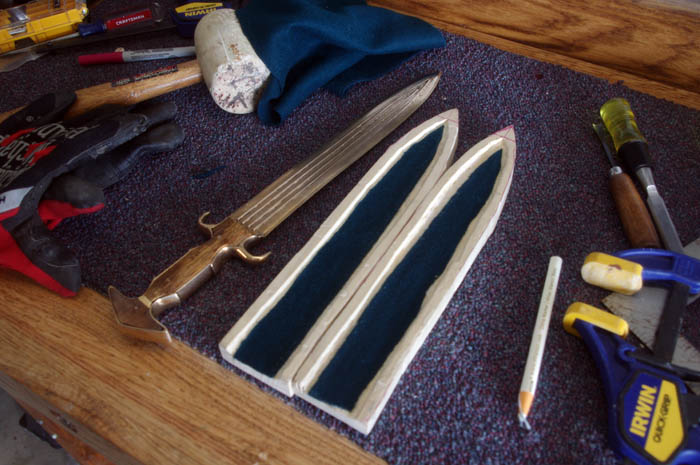
Last edited by Harry Marinakis on Wed 15 Oct, 2014 5:21 pm; edited 2 times in total
|
|
  |
 |
Harry Marinakis

|
 Posted: Wed 15 Oct, 2014 5:15 pm Post subject: Posted: Wed 15 Oct, 2014 5:15 pm Post subject: |
 |
|
Here's another interesting way to make a scabbard - by Findlithui - and it's the primary method that I use.
Download the PDF file here:
http://findlithui.deanandsandy.dyndns.org:808...ore1.1.pdf
(Note: The file seems to be missing, but I'll try to find another copy somewhere.)
|
|
  |
 |
Dean F. Marino

Location: Midland MI USA Joined: 24 Aug 2011
Posts: 229
|
|
  |
 |
Josh Wilson

|
 Posted: Wed 15 Oct, 2014 6:17 pm Post subject: Posted: Wed 15 Oct, 2014 6:17 pm Post subject: |
 |
|
|
I wrap the scabbard or handle in masking tape, and slice it gently off with a razor blade where the seams will go and use that as a pattern for when I go to cover them in leather. I have not made a wooden core yet, but will "soon". These links and resources will be a great help, thanks!
|
|
  |
 |
J. Nicolaysen

|
 Posted: Wed 15 Oct, 2014 7:59 pm Post subject: Posted: Wed 15 Oct, 2014 7:59 pm Post subject: |
 |
|
No, Soay are pretty rare. There are certain "hair breeds", Katahdin, Dorper and St. Croix that might fit your bill, and I know some people with the first two breeds. Navajo Churro sheep have similar characteristics of a double fleece like the Soay. I would think they might be the most similar. But in all cases I would think the pelts would be sheared leaving a thin layer of wool to make the most of the fleece before slaughter, at which point the pelt would be fine for such a use.
Wooled sheep such as Merino and Rambouillet may not quite be early medieval, but they were developed quite some time ago, late medieval period, and I think their characteristics would have been seen even earlier in Mediterranean areas. The Romans would use guard dogs with quite similar characteristics that the Basque and Turk and other shepherds still use today, 2000 years later. I wouldn't consider wooled sheep 'modern' but I suppose that is semantics. The lanolin in wooled sheep would help reduce rusting I think.
| Quote: | | I have used whatever wool or felt that I have lying around. Thicker is better, so I use felted wool. |
Felting is a pretty old technology. I would think that is a good way of keeping the lanolin in wooled sheep with a period type of construction.
Thanks for the replies, it's interesting.
|
|
  |
 |
Matthew Bunker

Location: Somerset UK Joined: 02 Apr 2009
Posts: 483
|
 Posted: Thu 16 Oct, 2014 2:10 am Post subject: Posted: Thu 16 Oct, 2014 2:10 am Post subject: |
 |
|
| J. Nicolaysen wrote: | | The lanolin in wooled sheep would help reduce rusting I think. |
I thought that too, until I started making lots of them. Then I discovered that what it actually does it trap every piece of dirt and crap on the blade when you put it into the scabbard.
| Quote: | | Felting is a pretty old technology. I would think that is a good way of keeping the lanolin in wooled sheep with a period type of construction. |
Although I do use felt sometimes (hand made stuff made for me by a lady in Wales), it's not period appropriate as far as we know. Analysis of all early medieval scabbards which have been lined shows that it was with skin rather than fleece or felt.
Fleece works well with blunt reenactment swords but, with sharp swords, the point can dig into the felt when inserting the sword into the scabbard, pulling it away from the wooden core and pushing it into the scabbard. Once that happens you have to dismantle the damn thing.
This doesn't happen with skin product linings.
"If a Greek can do it, two Englishman certainly can !"
|
|
  |
 |
Bryan Heff

|
 Posted: Thu 16 Oct, 2014 4:56 am Post subject: Posted: Thu 16 Oct, 2014 4:56 am Post subject: |
 |
|
I make my scabbards using the sandwich method of 3 pieces of poplar sandwiched together. I do this to simplify not needing to router or chisel out the profile for the blade. Now this makes for a thicker scabbard at first...the center of the scabbard which has been cut to match the profile of the blade will remain that thickness as I can't thin that any once its in the center, so the outer 2 pieces get electric planed to a rather thin section. Then I cut out the overall profile of the scabbard using a hand jig saw. Then a small hand planer to round the edges and fine tune the profile, then of course sandpaper etc.
I also line them using wool felt. 2 strips cut to fit the inside profile and glued in using spray adhesive from 3M (I think). The felt makes all the difference for me as with blades that have a lot of distal taper...as the internal thickness of the inside of the scabbard does not change (i.e. to match the taper) the felt acts as a buffer to fill space, so down deep in the scabbard it stays thick and cushions the blade and up by the throat where the blade is thickest...it can compress and hug the blade making for easy snug fits that will consistently give you a nice snug, hold it upside down all day long fits. I have made many using this method and have had very good results. Swords with very sharp points I will sometimes use a bit of linen to overlay the felt at the throat area. The tight weave of linen resists getting picked at and torn up by the point much better than the felt, once a few inches in I have had no issues as the sword starts to follow the scabbard and stay straight. I have had excellent, rattle free, snug and super smooth draws using this method.
I also just take a split second of time to make sure I am lined up when inserting the sword back in so to not poke the sides of the scabbard and prick the felt. No issues yet for with felt getting ripped and bunching up.
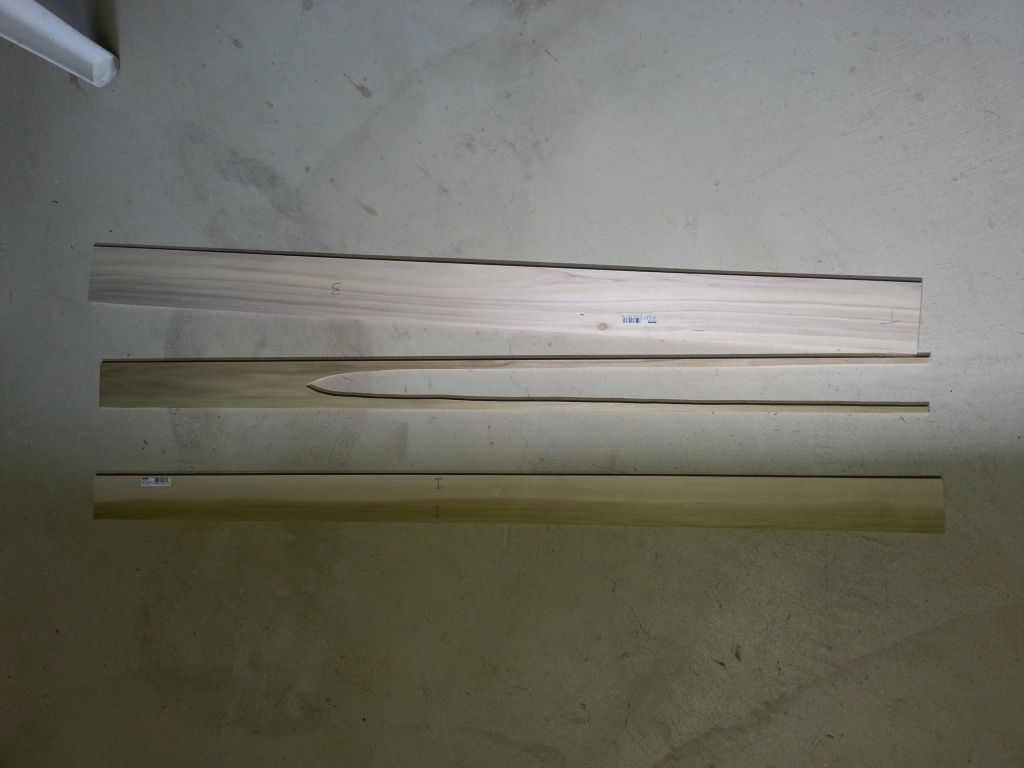
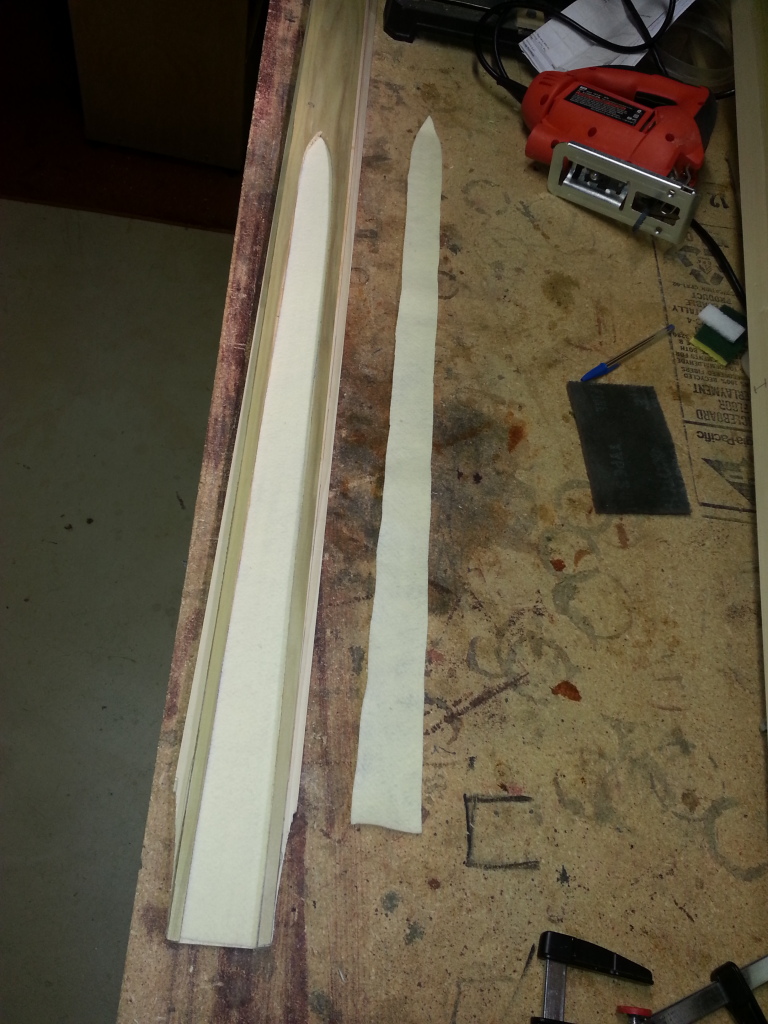
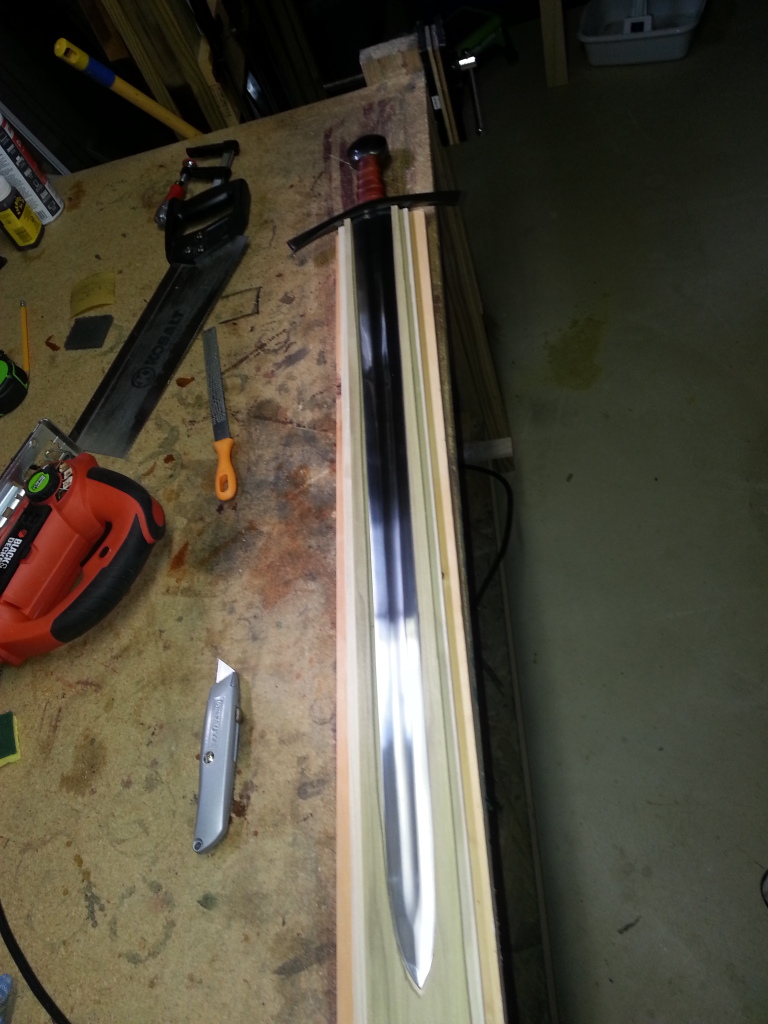

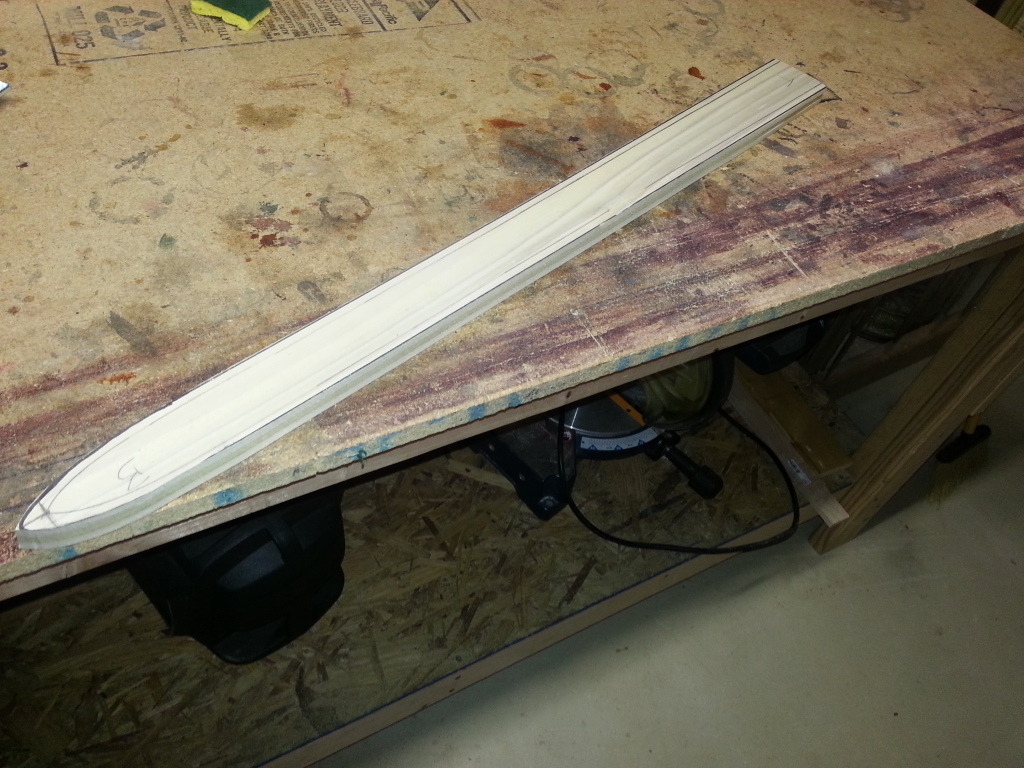
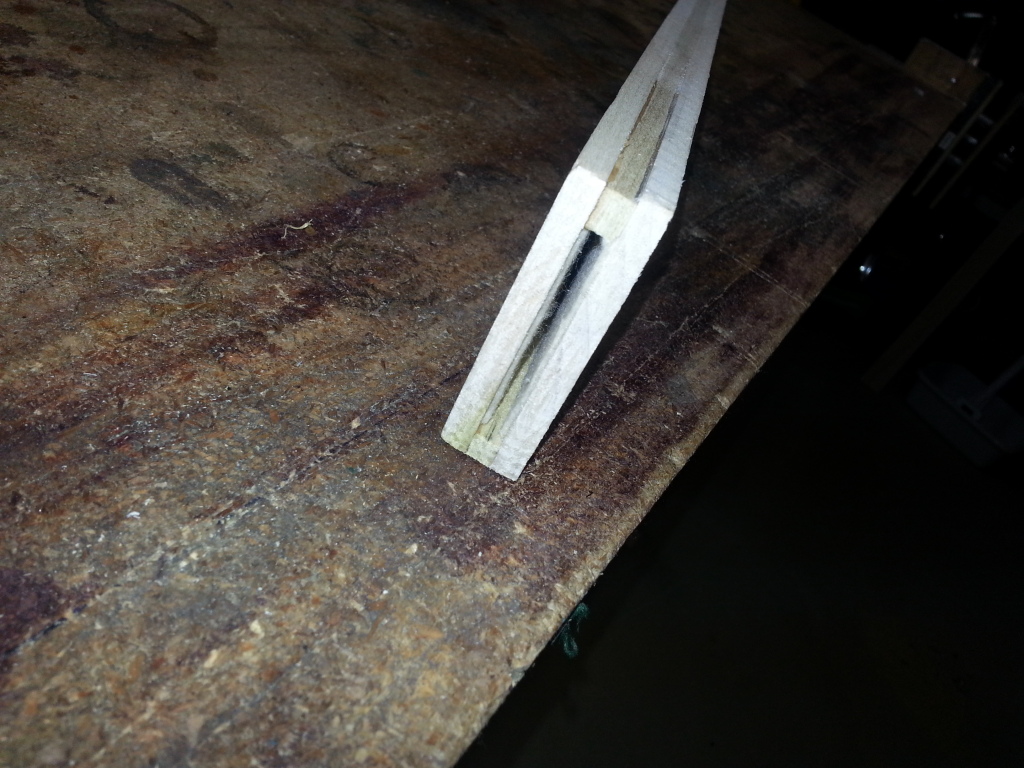
Before being planed down

after

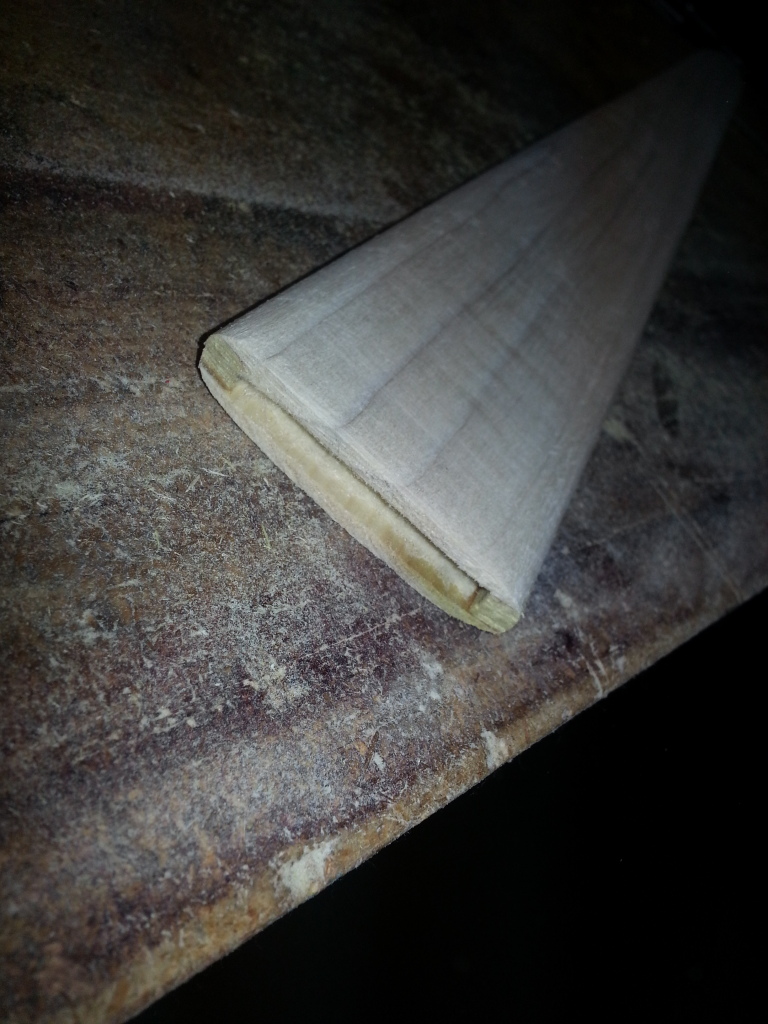
The church is near but the roads are icy. The tavern is far but I will walk carefully. - Russian Proverb
|
|
  |
 |
Harry Marinakis

|
 Posted: Thu 16 Oct, 2014 8:15 am Post subject: Posted: Thu 16 Oct, 2014 8:15 am Post subject: |
 |
|
| Josh Wilson wrote: | | I wrap the scabbard or handle in masking tape, and slice it gently off with a razor blade where the seams will go and use that as a pattern for when I go to cover them in leather. I have not made a wooden core yet, but will "soon". These links and resources will be a great help, thanks! |
I have tried that method, and ran into a couple of problems.
First, because of the differences in the thickness of the tape versus the leather, and the bending of the leather around the wood core, your leather will come up short at the back seam if you use the masking tape pattern.
Second, if there is a gap in the leather at the back seam, it's not good a good idea to stretch the leather tight to get the seam sewn closed because then tension can actually warp the thin wood core.
I had the wood core for my iron age sword carved perfectly. The sword went in and out of the core smoothly (no lining) and it gripped the sword tightly enough that the sword did not fall out when the wood core was inverted. There was a 1/8-inch gap in the leather at the back seam that I had to pull tight to sew the back seam closed. I think that this tension warped the wood core from an oval shape towards a more rounded shape - ever so slightly - so that when I was done the sword was very loose in the scabbard. I had to glue in a piece of leather at the throat to tighten it up again.
I like the method as devised by Dean Marino because you cut the leather cover to fit while you are gluing it to the wood core. You can make the seams match perfectly.
Here is my iron age scabbard that became loose because of a tight leather cover:
 Attachment: 50.83 KB Attachment: 50.83 KB

|
|
  |
 |
Harry Marinakis

|
|
  |
 |
Harry Marinakis

|
 Posted: Thu 16 Oct, 2014 8:41 am Post subject: Posted: Thu 16 Oct, 2014 8:41 am Post subject: |
 |
|
| Bryan Heff wrote: | | ...not needing to router or chisel out the profile for the blade... |
I use a straight chisel to mark the perimeter of the profile, and then finish carving by hand using a 5/8-inch fishtail gouge. If you keep the gouge sharp, it actually goes pretty quickly and it's not as difficult as you might expect. I finish up with some sandpaper and then a wire brush to make sure there are no residual grains leftover from the sandpaper.
 Attachment: 107.81 KB Attachment: 107.81 KB
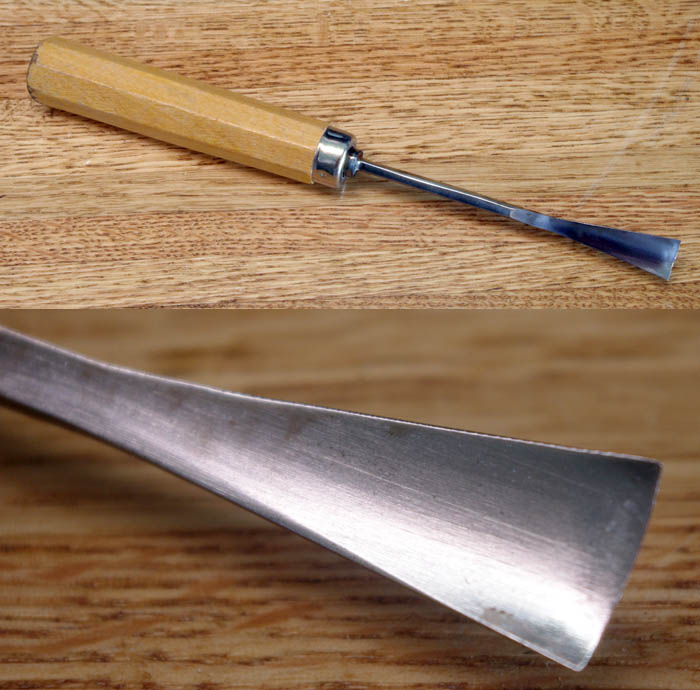
|
|
  |
 |
Harry Marinakis

|
 Posted: Thu 16 Oct, 2014 9:10 am Post subject: Posted: Thu 16 Oct, 2014 9:10 am Post subject: |
 |
|
Here's another trick that I use to get a good, snug-fitting scabbard without the use of a textile or skin lining.
When I am carving the cavity for the blade, periodically I clamp the two halves together and try to insert the sword. If you first rub down the blade with a red grease pencil, then the grease rubs off on the "high" points inside of the wood core, showing you exactly where you need to carve and/or sand some more.
 Attachment: 95.07 KB Attachment: 95.07 KB
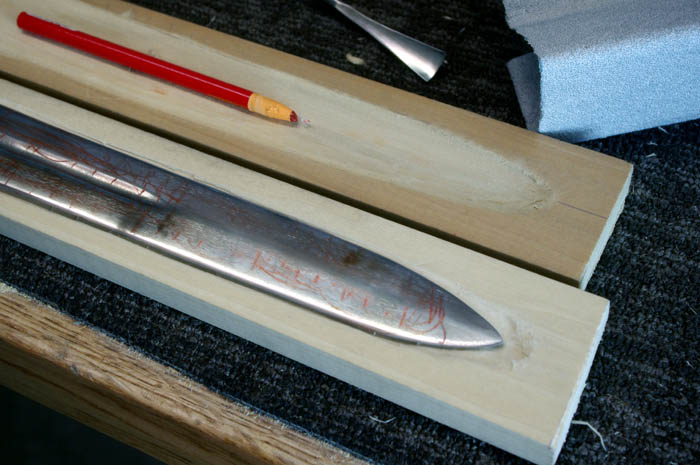
|
|
  |
 |
|
Jeffrey Faulk
|
 Posted: Thu 16 Oct, 2014 10:04 am Post subject: Posted: Thu 16 Oct, 2014 10:04 am Post subject: |
 |
|
| Harry Marinakis wrote: | Here's another trick that I use to get a good, snug-fitting scabbard without the use of a textile or skin lining.
When I am carving the cavity for the blade, periodically I clamp the two halves together and try to insert the sword. If you first rub down the blade with a red grease pencil, then the grease rubs off on the "high" points inside of the wood core, showing you exactly where you need to carve and/or sand some more. |
You can do the same thing with charcoal or graphite. You could even use an oil-pastel crayon. Just bear in mind that that if you go much past a grease pencil, it gets a bit messy... This is a good idea to use, though.
|
|
  |
 |
|
|

